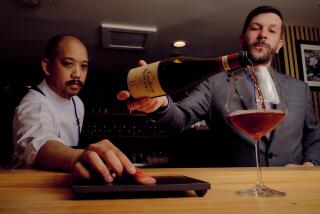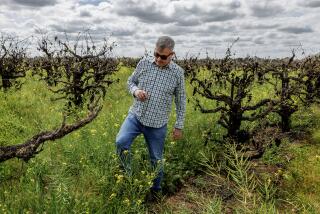Dot-Com Dregs of a Tasty Sort
NAPA, Calif. — If the self-proclaimed “World’s Largest Wine Auction” were actually a wine, Day One would probably resemble the 1998 Australian grenache on sale here this weekend: “Generous without extra power.”
Generous because 1% of all sales from the two-day event will be donated to the victims of the Sept. 11 terrorist attacks. Lacking oomph because not even the hope of a bargain came close to filling the 1,400 seats in the cavernous hangar at the Napa Valley Airport on Saturday.
It was originally billed as the event of the season here in America’s wine heartland, attracting ritzy hotels, rich collectors, retailers and no end of media coverage. But the auction became a hard sale to celebrate--the liquidation of once-vaunted Wine.com’s vast holdings, a postponed funeral with a good bar.
Or as wine buyer Brian Larky put it Saturday as he watched--but did not join in--the subdued action: “Natural selection is over. Now you’ve got the vultures diving in and picking over the carcass.”
And what a carcass it was. Everything for your drinking pleasure from 11 bottles of 1990 Dom Perignon brut to the 52 cases of Argentine malbec, final price a measly 64 cents a bottle. Collectors drooled over the 1921 Chateau D’Yquem Sauternes, which sold for a look-but-don’t-sip price of $2,000.
Ditto for the double magnum of unreleased Grace Family Vineyards 1999 cabernet sauvignon, the first of only eight bottled, etched and decorated with 23-karat gold leaf.
“This is a cult wine,” gushed auctioneer Nuri Otus as buyers slowly trickled in early Saturday morning. “This bottle is probably worth $10,000 to $20,000. We also have the Rombauer 1997 cabernet.”
Sold to the highest bidder for a far-more-modest $3,500, two double magnums of very special vintages headed for the Mill Valley cellar of one lucky Alan Abrams.
“At any other auction, it would have been a lot more,” said the very happy marketing consultant. “You can’t even buy that. Dick Grace only sells 750 [milliliter] bottles. Anything higher he donates.”
Which is exactly what he did in this instance. The double magnums of Rombauer and Grace cabernet sauvignon had been donated to help raise money for the United Way’s Sept. 11 fund. Unlike the rest of the wine, 100% of their sale price went to the charity.
A Symbol of Tech Excess
While the auction had morphed into a fund-raiser for a good cause, it certainly didn’t start out that way. In its original inception it was a fire sale, the poster child for grand tech excess gone expensively awry.
Wine.com was launched with the financial backing of big-name investors such as Amazon.com Inc. and the New York Times Co. It went belly up earlier this year and sold its domain name and customer list to its far more frugal rival, EVineyards of Portland, Ore.
The original auction was scheduled for Sept. 15-16. In the weeks leading up to the highly touted event, potential buyers from around the world contacted Realm Connect, the company that staged the auction.
By Sept. 11, some 2,000 attendees had preregistered, Otus said. But on Saturday, there were never more than a few hundred spectators in the Napa Valley hangar at any one time, most driving in from other Bay Area cities.
The auction was scheduled to begin at 11 a.m.; Otus paced the stage for another 30 minutes, waiting for the folding chairs to fill as a Patti LaBelle song pounded from the public address system.
But the Internet, which vanquished Wine.com, ended up saving the day for the auction. Low attendance was augmented by real-time sales on EBay; as of midday, more than 1,000 bids had been placed online.
“We had transference of real people to the Internet,” said Realm Connect President Roger Sanford. “The Internet has played a major role. I’m very surprised at how active the bidding was.”
Surprised and pleased. Because getting members of the somber audience to raise their paddles and bid seemed at times about as easy as raising venture capital for a dot-com venture in 2001. Just listen to him try to sell lots four, five and six, 72-bottle groupings of Altos de las Hormigas malbec:
“It’s a $100 start,” he intoned, fast. “$250, bid $275, six cases of wine, $275 bid $300. Any advance? Any advance on $325 a lot? Six cases of wine going once, going twice, yes just in time, $325 to $375, $325 to $375, $325 to $375, $325 to $375. Any advance? Going once, going twice. Sold! What do you want? One lot? Who wants the rest?”
Raising Capital for a Wine Investment
Paul Stenard, a bond broker and wine collector from Ross, Calif., drove up Saturday with about $15,000 not really burning a hole in his pocket. In a pre-attack spoof on an investor’s prospectus, he raised capital from several friends to buy wine en masse for the group.
“The Wine.com [mother of all wine auctions] should be quite a show,” Stenard wrote in his offering of “E” and “B” shares. The E, of course, stood for “expensive,” with a target of “big-time reds” and a sardonic goal for this economy: “Let’s party like it’s 1999!”
But after several hours on a hard folding chair, he still hadn’t bought a drop. Otus was making slow headway through the 1,400 lots on sale, and Stenard was feeling the pressure of an 8 p.m. dinner reservation: “The good stuff hasn’t come up, and I won’t be here when it does.”
He had come for some sport and the hope of a good deal or two, and ended up mostly marveling over the slight attendance. In his mind, the economy was more to blame than the attacks on the World Trade Center and the Pentagon.
“I know lots of people who would have dropped a couple thousand bucks at a wine auction,” he said. “Now they may think they should hang on to it.”
Who knows, though. The auction continues through today. Organizers still could luck out, fill those seats, rake in that money and end up like the 1997 Pine Ridge merlot on sale as Lot 70: “Most impressive is the finish.”
More to Read
Eat your way across L.A.
Get our weekly Tasting Notes newsletter for reviews, news and more.
You may occasionally receive promotional content from the Los Angeles Times.











